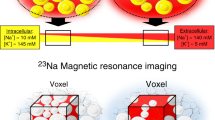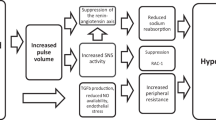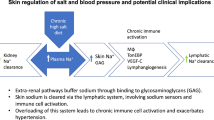Abstract
We recently reported that skin vasoconstriction to suppress transepidermal water loss (TEWL) leads to hypertension in renal injury model rats with impaired urine concentration ability. In this study, we investigated the pathogenesis of hypertension in spontaneously hypertensive rats (SHRs) from the perspective of renal water loss and skin water conservation. We compared the urinary concentration ability, body sodium and water balance, blood pressure, and TEWL in SHRs and control normotensive Wistar–Kyoto rats (WKYs). SHRs showed significantly higher urine volume and lower urinary osmolality than those of WKYs, while there were no significant differences in water intake, urinary osmolyte excretion, and plasma osmolarity between the groups. SHRs exhibited significantly higher blood pressure, skin sodium content, and lower TEWL compared with those is WKYs. Skin vasodilation, induced by elevating body temperature, increased TEWL in both SHRs and WKYs, and significantly reduced blood pressure in SHRs but not WKYs. These findings suggest that physiological adaptation can reduce dermal water loss in SHRs to compensate for renal water loss. Vasoconstriction required for successful cutaneous water conservation explains SHR hypertension. Renal concentration ability and skin barrier function for water conservation may become a novel therapeutic target for essential hypertension.
This is a preview of subscription content, access via your institution
Access options
Subscribe to this journal
Receive 12 print issues and online access
$259.00 per year
only $21.58 per issue
Buy this article
- Purchase on Springer Link
- Instant access to full article PDF
Prices may be subject to local taxes which are calculated during checkout




Similar content being viewed by others
Data availability
Data are included within this article.
References
Gao Q, Xu L, Cai J. New drug targets for hypertension: a literature review. Biochim Biophys Acta Mol Basis Dis. 2021;1867:166037.
Lane D, Lawson A, Burns A, Azizi M, Burnier M, Jones DJL, et al. Nonadherence in hypertension: how to develop and implement chemical adherence testing. Hypertension. 2022;79:12–23.
Kitada K, Daub S, Zhang Y, Klein JD, Nakano D, Pedchenko T, et al. High salt intake reprioritizes osmolyte and energy metabolism for body fluid conservation. J Clin Invest. 2017;127:1944–59.
Kovarik JJ, Morisawa N, Wild J, Marton A, Takase-Minegishi K, Minegishi S, et al. Adaptive physiological water conservation explains hypertension and muscle catabolism in experimental chronic renal failure. Acta Physiol. 2021;232:e13629.
Morisawa N, Kitada K, Fujisawa Y, Nakano D, Yamazaki D, Kobuchi S, et al. Renal sympathetic nerve activity regulates cardiovascular energy expenditure in rats fed high salt. Hypertens Res. 2020;43:482–91.
Wild J, Jung R, Knopp T, Efentakis P, Benaki D, Grill A, et al. Aestivation motifs explain hypertension and muscle mass loss in mice with psoriatic skin barrier defect. Acta Physiol. 2021;232:e13628.
Bianchi G, Fox U, Di Francesco GF, Giovanetti AM, Pagetti D. Blood pressure changes produced by kidney cross-transplantation between spontaneously hypertensive rats and normotensive rats. Clin Sci Mol Med. 1974;47:435–48.
Kidoguchi S, Kitada K, Nakajima K, Nakano D, Ohsaki H, Kittikulsuth W, et al. Hepatocellular carcinoma induces body mass loss in parallel with osmolyte and water retention in rats. Life Sci. 2022;289:120192.
Kopp C, Linz P, Wachsmuth L, Dahlmann A, Horbach T, Schöfl C. et al. (23)Na magnetic resonance imaging of tissue sodium. Hypertension. 2012;59:167–72.
Kopp C, Linz P, Dahlmann A, Hammon M, Jantsch J, Müller DN, et al. 23Na magnetic resonance imaging-determined tissue sodium in healthy subjects and hypertensive patients. Hypertension. 2013;61:635–40.
Wild J, Schüler R, Knopp T, Molitor M, Kossmann S, Münzel T, et al. Telmisartan lowers elevated blood pressure in psoriatic mice without attenuating vascular dysfunction and inflammation. Int J Mol Sci. 2019;20:4261.
Hu MY, Yang Q, Zheng J. The association of psoriasis and hypertension: focusing on anti-inflammatory therapies and immunological mechanisms. Clin Exp Dermatol. 2020;45:836–40.
Takeshita J, Wang S, Shin DB, Mehta NN, Kimmel SE, Margolis DJ, et al. Effect of psoriasis severity on hypertension control: a population-based study in the United Kingdom. JAMA Dermatol. 2015;151:161–9.
Šilhavý J, Mlejnek P, Šimáková M, Liška F, Kubovčiak J, Sticová E, et al. Sodium accumulation and blood capillary rarefaction in the skin predispose spontaneously hypertensive rats to salt sensitive hypertension. Biomedicines. 2022;10:376.
Johnson JM, Minson CT, Kellogg DL. Cutaneous vasodilator and vasoconstrictor mechanisms in temperature regulation. Compr Physiol. 2014;4:33–89.
Smith CJ, Johnson JM. Responses to hyperthermia. Optimizing heat dissipation by convection and evaporation: neural control of skin blood flow and sweating in humans. Auton Neurosci 2016;196:25–36.
Montero-Vilchez T, Cuenca-Barrales C, Rodriguez-Pozo JA, Diaz-Calvillo P, Tercedor-Sanchez J, Martinez-Lopez A, et al. Epidermal barrier function and skin homeostasis in atopic dermatitis: the impact of age. Life. 2022;12:132.
Luebberding S, Krueger N, Kerscher M. Age-related changes in skin barrier function - quantitative evaluation of 150 female subjects. Int J Cosmet Sci. 2013;35:183–90.
Nikolakis G, Makrantonaki E, Zouboulis CC. Skin mirrors human aging. Horm Mol Biol Clin Investig. 2013;16:13–28.
Roskos KV, Guy RH. Assessment of skin barrier function using transepidermal water loss: effect of age. Pharm Res. 1989;6:949–53.
Denic A, Glassock RJ, Rule AD. Structural and functional changes with the aging kidney. Adv Chronic Kidney Dis. 2016;23:19–28.
Weinstein JR, Anderson S. The aging kidney: physiological changes. Adv Chronic Kidney Dis. 2010;17:302–7.
Wadei HM, Textor SC. The role of the kidney in regulating arterial blood pressure. Nat Rev Nephrol. 2012;8:602–9.
Machnik A, Neuhofer W, Jantsch J, Dahlmann A, Tammela T, Machura K, et al. Macrophages regulate salt-dependent volume and blood pressure by a vascular endothelial growth factor-C-dependent buffering mechanism. Nat Med. 2009;15:545–52.
Wiig H, Schröder A, Neuhofer W, Jantsch J, Kopp C, Karlsen TV, et al. Immune cells control skin lymphatic electrolyte homeostasis and blood pressure. J Clin Invest. 2013;123:2803–15.
Acknowledgements
We thank Miho Yamauchi, Miyuki Namio, Kanoko Ueta, and Manami Shoji, technical assistants at Kagawa University. We also thank Edanz (https://jp.edanz.com/ac) for editing a draft of this manuscript.
Funding
This work was supported by Grants-in-Aid for Scientific Research (22H03514 to AN) and the Uehara Memorial Foundation (AN), and it was partially supported by Grants-in-Aid for Young Scientists (Start-up) (20K22876 to KK), the MSD Life Science Foundation (KK), and the Astellas Foundation for Research on Metabolic Disorders (KK).
Author information
Authors and Affiliations
Contributions
Conceptualization, KK, and JT; Methodology, TO, KK, NM, YF, and JT; Software, KK; Validation, TO, KK, YF, NM, SK, DN, HK, TM, JT, and AN; Formal Analysis, TO and KK; Investigation, TO, KK, NM, YF, and SK; Resources, KK, DN, HK, TM, JT, and AN; Data Curation, TO, KK, NM, YF, and SK; Writing - Original Draft Preparation, TO and KK; Writing - Review & Editing, TO, KK, SK, DN, HK, TM, JT, and AN; Visualization, TO and KK; Supervision, KK, DN, JT, and AN; Project Administration, KK, DN, JT, and AN; Funding Acquisition, KK and AN.
Corresponding author
Ethics declarations
Conflict of interest
The authors declare no competing interests.
Institutional review board statement
The animal research committee of Kagawa University reviewed and approved animal experiments.
Additional information
Publisher’s note Springer Nature remains neutral with regard to jurisdictional claims in published maps and institutional affiliations.
Rights and permissions
Springer Nature or its licensor holds exclusive rights to this article under a publishing agreement with the author(s) or other rightsholder(s); author self-archiving of the accepted manuscript version of this article is solely governed by the terms of such publishing agreement and applicable law.
About this article
Cite this article
Ogura, T., Kitada, K., Morisawa, N. et al. Contributions of renal water loss and skin water conservation to blood pressure elevation in spontaneously hypertensive rats. Hypertens Res 46, 32–39 (2023). https://doi.org/10.1038/s41440-022-01044-6
Received:
Revised:
Accepted:
Published:
Issue Date:
DOI: https://doi.org/10.1038/s41440-022-01044-6
Keywords
This article is cited by
-
Long-term health outcomes associated with hydration status
Nature Reviews Nephrology (2024)
-
2023 update and perspectives
Hypertension Research (2024)
-
Emerging topics on basic research in hypertension: interorgan communication and the need for interresearcher collaboration
Hypertension Research (2023)



